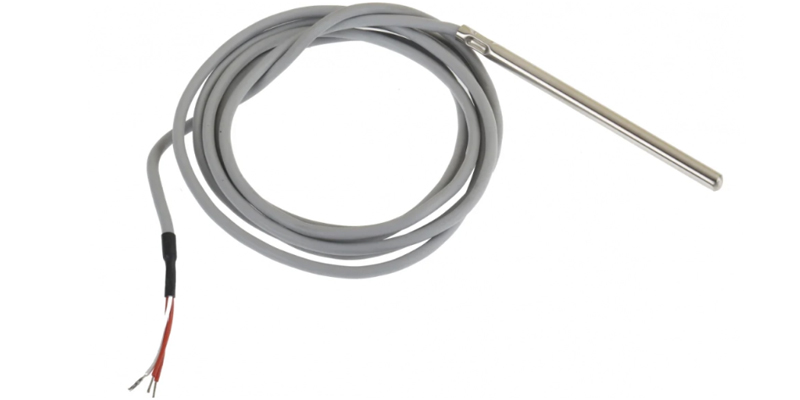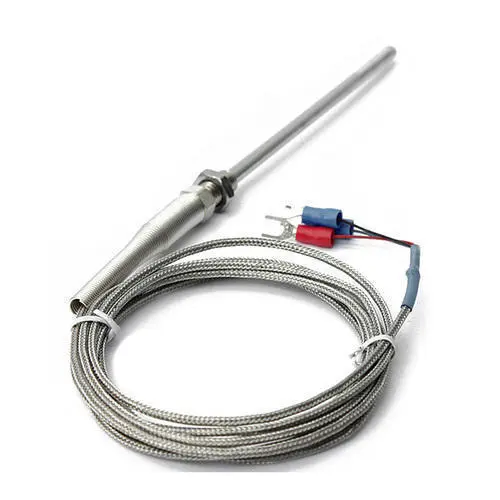
Introduction
Do you want to know what an RTD temperature sensor is, how it works and how to test it? Then you are in the right spot, we have answered all those questions and many more for you.
Enjoy your reading!
What is an RTD temperature sensor?
An RTD stands for “Resistance Temperature Detector” and it is a sensor whose resistance changes when its temperature changes and it is used to measure temperature. The RTD’s resistance increases linearly when the temperature increases. Many RTDs are called wire wound. They consist of fine wire wrapped around a glass or ceramic core. The wire is made of platinum. Another interesting thing is that the RTD elements are normally housed in a protective probe to protect them from the environment they are immersed in and to make them more robust.
Inexpensive RTDs are called thin film RTDs. They consist of a base ceramic with a fine Platinum track deposited on it.
How does a resistance thermometer work?
As we mentioned an RTD comprises of resistance element and insulated Platinum wires. Sometimes RTDs can have three or even four wires to increase accuracy allowing connection lead resistance errors to be eliminated. The resistance element is made of platinum because it is very long-term stable and it has a linear relationship between temperature and resistance, has a wide temperature range and it has a chemical inertness.
In terms of how it works, the RTD follows a basic principle. When the temperature of a metal increases, the resistance to the flow of electricity increases as well. An electrical current is passed through the sensor, the resistance element is used to measure the resistance of the current being passed through it. As the temperature of the resistance element increases the electrical resistance also increases.
The electrical resistance is measured in Ohms. The resistance value can then be converted into temperature based on the characteristics of the element. Usually, the response time for an RTD is between 0.5 and 5 seconds. This makes them very suitable for many applications.
How to test RTD temperature sensor?
To test your RTD sensor set your multimeter to a resistance mode. After that, check the readings across the terminals of the RTD. At room temperature (around 20°C) the reading should be around 110 ohms. Keep in mind that the reading value may be different, which depends on the room temperature.
Finally, place the RTD temperature sensor in ice water. Then, after a couple of minutes check the readings again. Now, you should get a lower number than the room temperature reading. That number should be around 100 ohms.
What is the difference between RTD and thermocouple?
There are a number of differences between thermocouples and RTD sensors. Below we have outlined the main ones.
- Thermocouples are usually smaller than RTDs, making them easier to use.
- Thermocouples offer a wider range of operation than RTDs (-200 to 2000°C), compared to -200 to 600° C. This means that thermocouples are suitable for more applications.
- Thermocouples offer a response time between 0.1 and 10s which is faster than the response time of RTD sensors.
- RTDs can self-heat while this issue is negligible with the thermocouples.
- Thermocouples are more sensitive than RTD temperature sensors. This is so because these react faster than RTDs with the variation in temperature.
- For thermocouples, the graph between resistance and temperature is not linear, while the one of RTDs is.
Why does an RTD have 3 wires?
As we mentioned earlier, most RTDs have two wires, however, others are made with three. This type of construction is used mostly in industrial applications where the third wire provides a method for removing the lead wire resistance from the sensor measurement.
Does an RTD need a power supply?
Resistance Temperature Detectors do require a power source to operate.
Why platinum is used in RTD?
As we mentioned earlier in the article, platinum is used in RTD sensors due to its stability and it provides repeatable and measurable results and has a broad temperature range. Moreover, platinum provides very low fluctuations in temperature readings, resulting in overall precision and stability of temperature measurement.
Conclusion
An RTD stands for “Resistance Temperature Detector” and it is a sensor which is used to measure temperature. It works following a basic principle of when the temperature of a metal increases, the resistance to the flow of electricity increases as well. An electrical current is passed through the sensor, the resistance element is used to measure the resistance of the current being passed through it. As the temperature of the resistance element increases the electrical resistance also increases.













